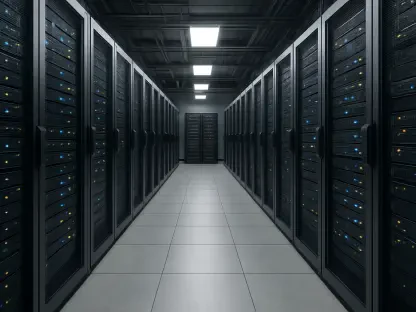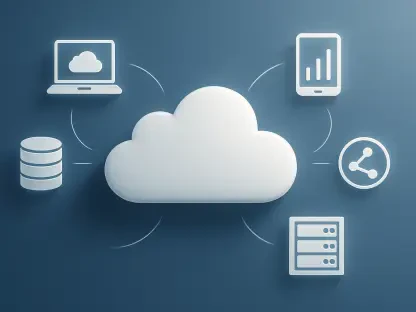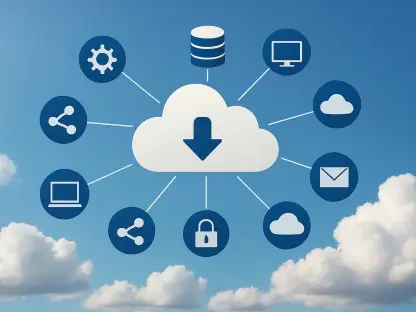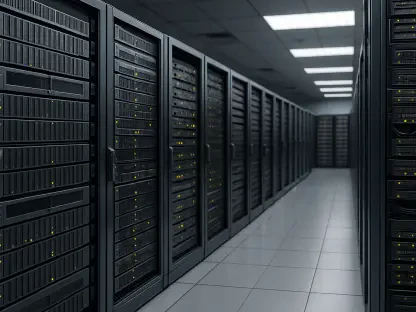In an era where digital transformation dictates the pace of business, the migration from conventional IT frameworks to cloud-native architectures built on containers, microservices, and distributed systems marks a profound evolution. This shift promises unparalleled agility and scalability, enabling organizations to innovate at breakneck speed. However, it also unveils a Pandora’s box of security challenges that traditional, perimeter-focused defenses are ill-equipped to address. Cloud-native security has risen as a pivotal force, weaving protective measures into every phase of the development lifecycle—from initial code creation to runtime operations. This isn’t merely about fending off threats; it’s about redefining resilience in a landscape where cyber risks grow more intricate daily. Unlike static, on-premises security models, this dynamic approach adapts to the rapid tempo of modern technology, positioning itself as a proactive shield for digital assets. The urgency is underscored by the staggering global surge in cloud adoption, with industries from finance to healthcare investing heavily in cloud infrastructure. Yet, with this expansion comes an enlarged attack surface, riddled with vulnerabilities like API weaknesses, insider threats, and flaws in automated pipelines. Cloud-native security is no longer a luxury but a critical necessity to confront these unique risks head-on, ensuring that innovation doesn’t come at the cost of vulnerability.
Beyond the technological realm, a cultural transformation is underway, reshaping how security is perceived within organizations. It’s no longer confined to isolated IT teams but is becoming a shared responsibility across developers, operations, and beyond. This philosophy, often encapsulated in the DevSecOps model, integrates security into daily workflows, catching potential threats early in the process. Such a shift marks a stark contrast to outdated, reactive methods where protection was an afterthought. Meanwhile, cutting-edge tools like zero-trust architectures, real-time threat detection, and AI-driven analytics empower businesses to anticipate and neutralize risks before they escalate. These advancements do more than defend; they enable fearless innovation, transforming security into a strategic advantage. As cloud investments soar—with over half of enterprises allocating more than $10 million annually—the parallel rise in sophisticated threats like AI-powered attacks and supply chain breaches keeps the stakes incredibly high. Navigating this complex terrain demands not just technology but a holistic rethinking of defense strategies.
The Global Cloud Boom and Its Security Implications
Investment Trends Across Regions
The relentless rise in cloud investments signals a global commitment to digital transformation, with certain regions setting the pace for adoption. Countries like the United States, Australia, and Singapore are at the forefront, aggressively integrating fully cloud-native environments to fuel innovation and operational efficiency. In contrast, emerging markets such as Brazil and India adopt a more measured approach, often constrained by smaller budgets or gradual implementation strategies. This disparity highlights how the maturity of cloud adoption directly influences spending patterns and, consequently, the scale of security requirements. Organizations in advanced markets are not just spending more; they’re investing in complex architectures that demand equally sophisticated protective measures. The correlation between cloud maturity and expenditure is evident, as businesses scaling their digital footprints prioritize security to safeguard intricate systems. This global trend underscores a critical reality: as reliance on cloud infrastructure deepens, so does the need for robust, adaptive security frameworks to protect against an ever-widening array of threats.
Another dimension of this investment surge is the clear divide between organizations at different stages of cloud integration. In regions like the U.K., enterprises with deeply embedded cloud systems consistently outspend those with rudimentary setups, reflecting a strategic focus on advanced services and architectures. This pattern holds true across the globe, where higher spenders often correlate with a greater commitment to cloud-native models. Such investment levels are not merely financial; they signify a broader recognition that scaling cloud operations necessitates parallel advancements in security. The data paints a compelling picture: businesses with mature cloud environments are more likely to allocate significant resources to defend against the unique vulnerabilities these systems introduce. This dynamic reinforces the urgency of aligning security investments with technological growth, ensuring that defenses evolve in tandem with the complexities of modern digital ecosystems.
Maturity Levels and Security Demands
Cloud maturity doesn’t just drive spending; it fundamentally shapes the security landscape for organizations worldwide. Enterprises with advanced or fully native cloud setups face a broader and more intricate attack surface compared to those with basic implementations. This heightened exposure stems from the adoption of multi-cloud environments, containerized applications, and automated workflows, all of which amplify the potential for breaches if left unsecured. As a result, these organizations are compelled to invest in cutting-edge security solutions like zero-trust models and real-time monitoring to mitigate risks. The link between maturity and security needs is unmistakable—greater reliance on cloud technologies translates to a pressing demand for defenses that can keep pace with dynamic, distributed systems. This trend is particularly evident in leading markets where the push for innovation must be balanced with robust protection to maintain trust and operational integrity.
Moreover, the regional variations in cloud maturity reveal significant implications for global cybersecurity strategies. In nations like Australia and Singapore, where a substantial percentage of businesses operate fully cloud-native environments, the emphasis on security is not just reactive but strategic, positioning it as a cornerstone of digital transformation. Conversely, in markets with slower adoption rates, such as parts of Europe or emerging economies, the security focus may still lean toward foundational measures rather than comprehensive, integrated frameworks. This discrepancy highlights a critical challenge: ensuring that security capabilities scale proportionately with cloud maturity, regardless of geographic or economic context. Bridging this gap requires tailored approaches that address both the technological and cultural dimensions of security, ensuring that even less mature markets are equipped to handle evolving threats as they expand their cloud footprints.
Security Challenges in Cloud-Native Environments
Evolving Threats and Expanding Attack Surfaces
The inherent flexibility of cloud-native environments, while a boon for scalability, introduces a host of new security threats that demand innovative countermeasures. Among the most pressing are AI-driven cyberattacks, where adversaries leverage machine learning to automate reconnaissance, craft adaptive malware, and bypass traditional detection mechanisms. These sophisticated attacks often target misconfigured cloud workloads, unsecured data flows, and vulnerable APIs, exploiting gaps that legacy systems fail to address. To combat this, organizations must deploy equally advanced tools, such as behavioral analytics and continuous monitoring, to detect anomalies and respond in real time. The battle against AI-powered threats is not just about technology but about staying ahead of attackers who are constantly refining their tactics. As the cloud landscape evolves, so must the defenses, ensuring they are as dynamic and intelligent as the threats they aim to neutralize.
Insider threats represent another formidable challenge, intensified by the complexities of identity and access management in multi-cloud setups. Whether malicious or accidental, breaches from within bypass conventional perimeter defenses, exploiting trusted access to wreak havoc. Addressing this risk requires a shift to zero-trust architectures, which assume no user or system is inherently safe and enforce strict verification at every level. Coupled with user behavior analytics and tightly controlled privileges, these models help identify and mitigate insider risks before they escalate. Additionally, API vulnerabilities further expand the attack surface, as weak authentication or exposed endpoints provide attackers with entry points to manipulate systems or steal sensitive data. Implementing robust API security through gateways and real-time monitoring becomes essential to close these gaps, safeguarding the integrity of cloud-native operations against an increasingly diverse range of threats.
Risks in Automated Development Pipelines
The adoption of automated CI/CD pipelines has revolutionized software development by accelerating delivery and enhancing agility, but it also introduces significant security risks if not properly managed. These pipelines, critical to cloud-native workflows, can become weak links through third-party vulnerabilities, insecure secrets management, or compromised build environments. Supply chain attacks, where malicious code is injected into dependencies or tools, are a growing concern, capable of propagating flaws into production systems undetected. Securing these pipelines demands a proactive approach, integrating automated vulnerability scanning and code analysis early in the development process. By identifying and addressing issues before deployment, organizations can prevent costly breaches that undermine trust and disrupt operations, ensuring that speed does not come at the expense of safety.
Furthermore, the complexity of CI/CD environments often amplifies the challenge of maintaining a secure development lifecycle. Misconfigurations or overlooked flaws in automation scripts can create exploitable gaps, allowing attackers to infiltrate systems at critical junctures. Adopting DevSecOps practices, which embed security into every stage of the pipeline, offers a viable solution by fostering collaboration between development, operations, and security teams. This shift-left mentality—prioritizing security from the outset—reduces the likelihood of late-stage vulnerabilities and minimizes remediation costs. Real-time monitoring and strict access controls within build environments further bolster defenses, ensuring that potential threats are detected and neutralized swiftly. As automated pipelines become the backbone of cloud-native innovation, securing them is not just a technical necessity but a strategic imperative for sustaining long-term resilience.
Strategies for a Secure Cloud-Native Future
Building Unified and Resilient Frameworks
As the challenges of cloud-native environments mount, the adoption of unified security platforms emerges as a cornerstone for robust cyber defense. These platforms, designed to operate across diverse cloud architectures, address the inefficiencies of fragmented tools by providing end-to-end visibility and protection. They scale seamlessly with innovations like container orchestration and microservices, ensuring that security keeps pace with technological advancements. By centralizing control and reducing integration complexities, such frameworks not only enhance operational efficiency but also close visibility gaps that attackers often exploit. This unified approach is particularly vital in multi-cloud setups, where disparate systems can create blind spots if not cohesively managed. Embracing platformization represents a strategic move to future-proof defenses, enabling organizations to navigate the evolving threat landscape with confidence and agility.
Equally important is the adaptability of these frameworks to emerging use cases and regulatory demands. As businesses expand their cloud footprints, they encounter diverse compliance requirements and operational challenges that fragmented security tools struggle to address. Unified platforms offer a scalable solution, integrating advanced capabilities like real-time threat detection and automated response mechanisms to counter sophisticated attacks. This scalability ensures that security evolves alongside cloud innovation, preventing the delays and vulnerabilities associated with outdated, siloed systems. Moreover, by streamlining security operations, these platforms reduce overhead costs and enable teams to focus on strategic priorities rather than reactive firefighting. In a digital ecosystem where agility is paramount, building resilient frameworks through unified platforms is a critical step toward sustaining trust and operational continuity.
Securing Innovation Through Cultural and Technological Shifts
The secure adoption of transformative technologies like AI and automation stands as a pivotal strategy for balancing innovation with risk management in cloud-native environments. While AI-powered tools and generative AI accelerate software delivery and enhance efficiency, they also introduce vulnerabilities such as insecure code generation and potential data leaks. Establishing strict governance policies and integrating automated security testing within CI/CD pipelines are essential to mitigate these risks. Additionally, deploying Data Security Posture Management tools helps organizations maintain visibility over data flows and ensure compliance with regulatory standards. This dual focus on innovation and security ensures that the benefits of AI and automation are harnessed without compromising the integrity of cloud systems, striking a balance that is crucial for long-term success in a competitive digital landscape.
Beyond technology, fostering a DevSecOps-driven culture marks a profound shift in how security is embedded into organizational practices. This approach breaks down traditional silos, encouraging collaboration across development, operations, and security teams to integrate protective measures into daily workflows. Continuous education and shared performance metrics reinforce this collaborative mindset, ensuring that security is not an afterthought but a core component of innovation. Unlike traditional DevOps, which prioritizes speed through development-operations synergy, DevSecOps elevates security as a shared responsibility, automating critical functions like vulnerability scanning and compliance checks within pipelines. This cultural transformation, supported by technological tools, empowers organizations to proactively manage risks, delivering secure software at speed. As cloud-native environments continue to dominate, such cultural and technological shifts are instrumental in redefining cyber defense for a safer digital future.









